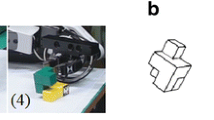Abstract.
Assembly planning is the problem of finding a sequence of motions to assemble a product from its parts. We present a general framework for finding assembly motions based on the concept of motion space . Assembly motions are parameterized such that each point in motion space represents a mating motion that is independent of the moving part set. For each motion we derive blocking relations that explicitly state which parts collide with other parts; each subassembly (rigid subset of parts) that does not collide with the rest of the assembly can easily be derived from the blocking relations. Motion space is partitioned into an arrangement of cells such that the blocking relations are fixed within each cell. We apply the approach to assembly motions of several useful types, including one-step translations, multistep translations, and infinitesimal rigid motions. Several efficiency improvements are described, as well as methods to include additional assembly constraints into the framework. The resulting algorithms have been implemented and tested extensively on complex assemblies. We conclude by describing some remaining open problems.
Similar content being viewed by others
Author information
Authors and Affiliations
Additional information
Received November 15, 1996; revised January 15, 1998.
Rights and permissions
About this article
Cite this article
Halperin, D., Latombe, JC. & Wilson, R. A General Framework for Assembly Planning: The Motion Space Approach . Algorithmica 26, 577–601 (2000). https://doi.org/10.1007/s004539910025
Issue Date:
DOI: https://doi.org/10.1007/s004539910025




